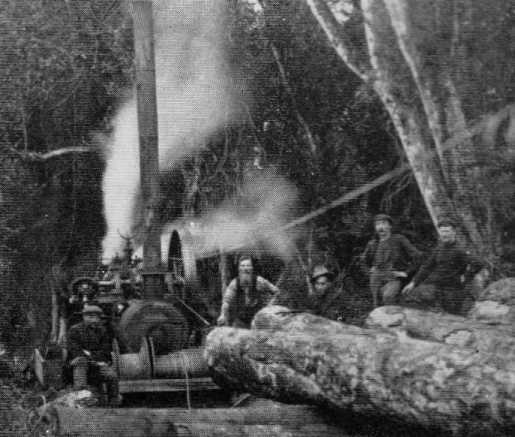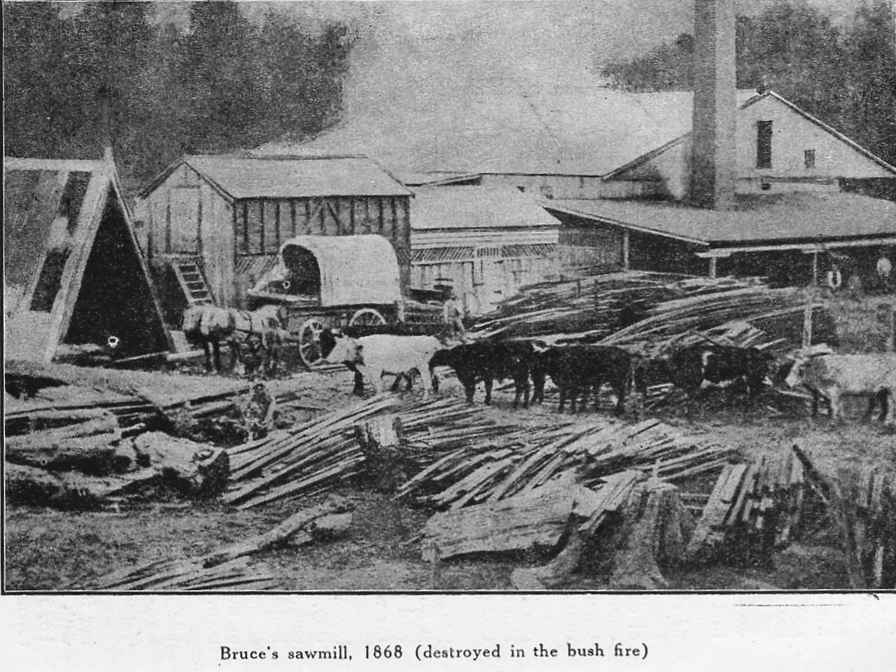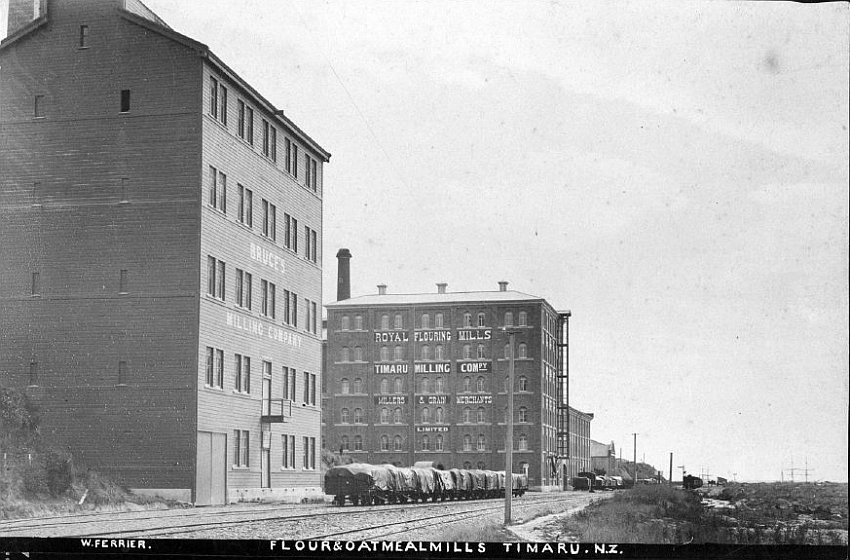
The European settlement at Te Waimate
developed as a timbertown, home to a small but thriving sawmilling
industry from the early 1860's. Over 9000 hectares of black and white
pines, totara, ngaio, broadleaf and other native forest covered the slopes
of the hills providing building materials for the rush of runholders who
were quick to take up freehold sections, and saw-milling became a major
industry.

The demand for timber from the
fast growing seaports of Timaru and Oamaru gathered pace. Shortly
after he arrived, James Bruce worked as a bushman at Waimate
and the bush suffered its first major fire on 18th Nov 1865 when
sparks from a billy ignited a patch of dry fern. The sawmillers escaped
with their lives, but little else - a grim warning that fires were
the result of pure carelessness - travellers failing to extinguish cooking
fires, shepherds burning grass land too near the bush, or foresters
billies setting scrub alight.
By 1867 James had the first steam
saw-mill in Waimate near Garlands Bridge, in the very heart of the
bush.

Wise's New Zealand Directory in 1872-3 Waimate: James
Bruce, timber merchant
In 1872 James Bruce
successfully tendered for 20,000 totara and black pine sleepers for
the railways - the price was 3s 6d a
sleeper
Alpheus Hayes a Canadian came to New
Zealand in 1871 and he found employment on building the Rangitata bridge.
He made several journeys to Waimate Bush to select material for the
bridge, and seeing the possibilities of the timber trade, settled in
Waimate at the end of that year opening a mill just above Bruce's and was
very successful until the bush fire of 1878. He extended his tramway after
the fire further into the bush to open up 400 acres of good timber,
principally totara and black and white pine and kept the saw-milling
business going till the early nineties, when he sold out and took up
farming.
James Bruce was first chairman of the Waimate
County Council. 4/1/1877

1877 Evening Post, 22 September 1877:
Last night a crowded indignation meeting was held at Waimate to give expression to public opinion in regard to certain remarks of Mr. Wakefield in the Assembly in reference to the people of Waimate. Mr. James Bruce, the Chairman of the Waimate County Council, was in the chair. A series of very strong resolutions were adopted, condemnatory, of Mr. Wakefield's action and affirming the absolute necessity of getting a new Resident Magistrate's Court erected. Mr. Wakefield was afterwards burned in effigy.
Last night a crowded indignation meeting was held at Waimate to give expression to public opinion in regard to certain remarks of Mr. Wakefield in the Assembly in reference to the people of Waimate. Mr. James Bruce, the Chairman of the Waimate County Council, was in the chair. A series of very strong resolutions were adopted, condemnatory, of Mr. Wakefield's action and affirming the absolute necessity of getting a new Resident Magistrate's Court erected. Mr. Wakefield was afterwards burned in effigy.
The railway arrived in 1877 and by
year's end, but despite five saw-mills cutting furiously they were unable
to meet demand - Bruce's and Hayes' were the most important. Just
when prosperity seemed assured, the growing community was overwhelmed in
the exceptionally dry spring of 1878.
On November 12th a strong nor'wester
fanned a grass fire to frightening proportions and flames from the great
sawdust heaps that were always quietly smoldering spread over the
surrounding bush, and soon fires were burning in several places. By 4
o'clock in the afternoon, the five saw-mills and about 70 cottages had
been destroyed. By night the bush was burning over several miles and when
the fire was eventually put out eight days later, 70 families were left
homeless after the destruction of their cottages, many lost their
possessions, and one of the country's finest totara forests had been
destroyed, the bush had disappeared except for two areas known as Bush
Point and Kelceys Bush.
Fortunately no lives were lost but
the timber industry was finished. There was hardship and it was
twenty-five years before Waimate regained thet 1,400 of population it
possessed at the outbreak of the great bush fire. Read here
James Bruce left Waimate and at
Timaru he started to build his flour, oats (Royal Flouring Mill) and saw
mills in late 1878. He bought the sailing ship "Nightingale" and shipped
kauri logs for his mill building, floated them ashore, hauled them
up the beach with an engine and over a bridge above the
railway to the site of the works. These fine mill buildings were destroyed
by fire in '81 The fire damage was estimated at £17000 as the mill had a
capacity of 100 tons of flour a week - very big for those times.
Timaru Herald, 15 Feb 1881: The brigantine
Sarah and Mary is daily expected from Kaipara, with a cargo of timber for
Mr James Bruce.

James Bruce started rebuilding immediately. He
went to America to study the latest methods of milling - he charted
the "Campsie Glenn" and brought back in her the first complete roller mill
plant to be installed in NZ. and superintended the
installation of the new machinery himself. His enterprise had been backed
by Julious Mendelson and when Mendelson died in 1882 the mills closed down
for a time. A company was then
formed to take over the mill. The Royal Flouring and Oatmeal Mills (Bruce
& Company Ltd) bought the mill in October 1883 and work resumed. James
Bruce was manager of the mill, but in 1885 there was a dispute with the
managing director. Bruce was dismissed and the company liquidised. The
Timaru Milling Company was formed in 1886 and took over the running of the
mill. (Src Anderson "Sth Canterbury"; Src. Photo: Sth Canterbury Museum) Read more
Death: Bruce - At Latter street,
Timaru, on Oct 24th, James Bruce, in his 73rd year
OBITUARY: Timaru Herald; Oct 24 1903
Obituary: James Bruce. The late Mr Bruce was a man of mark in the early days of South Canterbury, first as a saw miller at Waimate. He then established a sawmill at Timaru and erected the first flour mill, which was burned down. He re-erected it on a larger scale as the first Roller mill in the colony. Later he lived for some years in Wellington but returned to Timaru two years ago an invalid.
Obituary: James Bruce. The late Mr Bruce was a man of mark in the early days of South Canterbury, first as a saw miller at Waimate. He then established a sawmill at Timaru and erected the first flour mill, which was burned down. He re-erected it on a larger scale as the first Roller mill in the colony. Later he lived for some years in Wellington but returned to Timaru two years ago an invalid.

